Unit11写作教学设计人教版英语九年级全册
九年级英语unit11英文教案(含5篇)

九年级英语unit11英文教案(含5篇)第一篇:九年级英语unit11英文教案Unit 11 Could you please tell me where the restrooms are? Ⅰ. Teaching Aims and Demands 1. Knowledge Objects(1)Key Vocabulary restroom, shampoo, stamp(2)Target Language Excuse me. Can you please tell me where I can get a dictionary? Sure.There’s a bookstore on River Road. 2. Ability Objects (1)Train students’ listening ability.(2)Train students’ communicative competence.3.Moral Object Helping each other is very important. It is a good quality.Ⅱ. Teaching Key Point Target Language Ⅲ. Teaching Difficult Points 1.How to train students’ listening ability.2.How to train students’ communicative competence.Ⅳ.Teaching Procedures Step Ⅰ Revision T: You’re new to this school. You need to know where the main office is.How can you ask where the main office is? S1: Where’s the main office? T: That’s one way to ask. But there is a more polite way you can ask.You can say, “Can you tell me where the main o ffice is?” Class repeat. Can you tell me where the main office is? Ss: Can you tell me where the main office is? T: That’s correct.Now let’s say you want to know where Classroom 1 is. How can you ask? S2: Can you tell me where Classroom 1 is? T: Good!Ther e’s another polite way you can ask: Could you tell me how to get to Classroom 1? Class repeat. Could you tell me how to get to Classroom 1? Ss: Could you tell me how to get to Classroom 1? T: That’s right. Very good.Step Ⅱ 1a Go through the instructions w ith the class.Read the list of things to the class. To review the meaningof each item on the list, invite different students to say each phrase in their own words.Point to the lettered parts of the picture one by one. Ask a student: What kind of place is this? What do they sell there? Do we have one in our community? What is the name of the one in our community? Point out the sample answer.Say, The letter c is in front of the words buy shampoo because you could buy shampoo in a department store.There may be more than one correct answer for some blanks.While students are working, move around the room offering help as necessary.Step Ⅲ 1b Read the instructions to students. Point out the two conversations that are shown in the picture. As you listen, fill in the blanks with words you hear in the recording. Play the recording the first time.Students only listen.Play the recording a second time.This time ask them to fill in the blanks with the words you hear. Check the answers with the whole class.Step Ⅳ 1c Read the instructions to the class.Point out the list of things people need and the pictures of the places in activity 1a.Say.Look at activity la.Have a conversation with a partner. Ask your parter politely where you can do theseThe First Period thi ng and then answer your partner’s questions.As students work, listen to some pairs in order to check the progress and help with pronunciation as needed.After students have had a chance to practise several exchanges, ask some pairs to come to the front of the classroom and act out their conversations.Step Ⅴ Homework Review the target language.Ⅰ. Teaching Aims and Demands 1. Knowledge Objects(1)Key Vocabulary escalator, furniture, exchange money, elevator(2)Target Language Excuse me.Do you know where I can exchange money? Sure.There’s a bank on the second floor. Take the escalator to the second floor and turn right. The bank is next to the bookstore.2.Ability Objects(1)Train students’ listening ability.(2)Train students’ communicative competence. 3. Moral Objects If someone asks you how to get to the place he wants to go to, you should tell him the way correctly.Ⅱ.Teaching Key Points 1.Key Vocabulary exchange money 2. Target Language Excuse me. Do you know where I can exchange money? Sure.There’s a bank on the second floor.3.Structures Do you know where I can buy shampoo? Could you tell me how to get to the post office? Can you please tell me where I can get a dictionary? Ⅲ. T eaching Difficult Points 1. Indirect questions.2.How to improve studen ts’ listening ability.Ⅳ.Teaching Procedures Step Ⅰ Revision Check homework.Step Ⅱ 2a Read the instructions and point to the list of directions.Get students to name the items in the picture such as escalator, elevator, shoe store, and so on.Play the recording. Students only listen.Tell them that the picture may help them understand what they are hearing.Play the recording again. This time ask students to write a number next to four of the directions.Check the answers with the whole class.Step Ⅲ 2b Point tothe picture. Say, now you will hear the recording again. This time show where the boy went as he followed the directions to the drug store. Draw a line on the picture in your book.Play the recording again and ask students to draw the line on their own. Check the answer with the class.Step Ⅳ 2c Ask a pair of students to read the sample conversation aloud to the class.Read the instructions aloud.Say.Make conversations using information about the places in the picture with your partners.As students work, move around the classroom checking the progress of the pairs and offering help as needed.The Second Period Ask one or two pairs to say their conversations to the class. Ask the rest of the class to look at the picture as they listen.Step Ⅴ Homework Ask the students to write three sentences with the starters of the structures.The Third Period Ⅰ.Teaching Aims and Demands 1.Knowledge Objects(1)Key Vocabulary hang out, fresh, advantage, disadvantage, block(2)Target Language Go out the front door and take a right. Walk about three blocks. Go past the park, and turn left onto Oak Street.3.Moral Objects Anything has both advantages and disadvantages.We should treat everything correctly.Ⅱ.Teaching Key Point Train students’ listening, speaking, reading and writing ability.Ⅲ.Teaching Difficult Points How to improve students’ integrating skills.Ⅳ.Teaching Procedures Step Ⅰ Revision T: Yesterday we learned the structures.Do you know where…? Could you tell me how to get to…? Can you ple ase tell me where…? Now who can make sentencesby using the structures? Step Ⅱ 3a Read the instructions. Point out the blank lines under the words Advantages and Disadvantages below the interview.You will write your answers in these blanks.Read the first two sentences at the top of the article.Explain that the interviewer will talk to several teenagers.Get students to read the interview on their own quickly.When they have finished, ask if there are any words or sentences they don’t understand. If there are, explain them.Ask students to read the interview again and write the advantages and disadvantages.Check the answers with the whole class.Step Ⅲ 3b Read the instructions. Point out the conversation in the box and invite two students to read it to the class.Point out the list of advantages and disadvantages in Activity 3a. Say, You can use these items and any other items you can think of as you talk about places you usually hang out.Ask students to work in groups of four or five. As they work, move around the classroom helping the groups as necessary.Make sure they talk about both advantages and disadvantages.Ask several groups to act out part of their conversation to the class.Step Ⅳ 4 Read the instructions to the class. Get students to look back at the picture and activities on the first page of this unit.Point out the sample language in the box. Invite a student to read it to the class.Ask students to say the names of some stores and other places in the community and write them on the board. Say, Each group can choose three of these places to write about, or you canchoose another place you know of Write careful directions from the school to each place, but do not say the name of the place. You can use the words this place instead. In order to help students work, draw a simple map showing the school and several nearby streets.When the groups are ready, they read their directions to the class and the other students guess the name of the place they are talking about.Step Ⅴ Homework 1. Ask students to choose two places in the community and write careful directions from the school to each place.2. Finish off the exercises on pages 46~47 of the workbook.Ⅰ. Teaching Aims and Demands 1. Knowledge Objects(1)Key Vocabulary fascinating, convenient, safe, restroom, inexpensive(2)Target Language Can you tell me where there’s a good place to eat? Of course. What kind of food do you like? 2.Ability Objects(1)Train students’ writing and speaking ability.(2)Train students’ ability to understand the target language in spoken conversation.(3)Train students’ ability to use the target language.Ⅱ. Teaching Key Points 1. Key Vocabulary convenient, safe, restroom inexpensive 2.Target Language Can you tell me where there’s a good place to eat? Of course. What kind of food do you like? Ⅲ. Teaching Difficult Points 1.How to improve students’ writing and speaking ability.2.How to use the target language.Ⅳ.Teaching Procedures Step Ⅰ Revision Check homework.Step Ⅱ 1a Go through the instructions with the class.Read the words in the box to the class and ask if there are any of these words that students don’t understand. If so, helpstudents to explain the meaning of the word.Then read the instructions again and point out the sample answer.Get a student to read the sample answer to the class. Point out that students can also write other words after the word clean. Ask students to write words from the box in the blanks on their own.Help students if needed.Correct the answers by having students read what qualities he or she listed.Step Ⅲ 1b Read the instructions to the class.Point out the example in the box.Invite two students to read it to the class.Now work with a partner.Look at the words in the box and use them to talk about places in your own city.As students talk, move around the classroom checking their work. Offer language support as needed.Invite several pairs of students to say their conversations to the class.Step Ⅳ 2a Point to the picture and ask students to tell what is happening. If necessary, explain that the scene shows a family on vacation.They are asking the man for information about various things to do in Sunville.Go through the instructions and point to the chart.Play the recording. Students only listen the first time.Play the recording again. Ask students to write the places people ask about.Check the answers with the whole class.Step Ⅴ 2b Read the instructions and point to the chart. You will hear the same recording again.This time listen carefully to the answers the cleck gives. Write the answers in the blanks alone.The Fourth Period Point out the sample answer.Play the recording again.Ask students to write their answers in the blanks. Check the answers.Step Ⅵ 2c Point to the sample conversation. Invite two students to read it to theclass. Read the instructions. Role play the conversations you hear on the tape.Get students to work in pairs.Move around the room checking the progress of the pairs and offering help as needed.Ask one or two pairs to say their conversations to the class.Step ⅦHomework Talk about some places using the words in la, then write down the conversations.Ⅰ. Teaching Aims and Demands 1. Knowledge Objects(1)Key Vocabulary water slide, clown, dress up, have fun(2)Practise reading an article.(3)Practise writing something using the target language.2.Ability Objects(1)Train students’ reading ability.(2)Train students’ writing ability.Ⅱ. Teaching Key Point Practise reading and writing using the target language.Ⅲ. Teaching Difficult Point How to write a guide to a place.Ⅳ.Teaching Procedures Step I Revision Review the target language presented in this unit. Check homework. Step Ⅱ 3a Invite a student to read the article aloud to the class. Correct any pronunciation errors to make sure the student is providing a good model for the rest of the class.Ask students to read the article again and complete the chart. Get students to do the work on their own or in pairs. As they work, move around the classroom and offer help as necessary. Check the answers. Step m 3b Read the instructions to the class. Point to the first two sentences and ask a student to read these sentences to the class.Look back at Activities 2a and 2b. Use this information to help you complete the guide to Sunville. Ask the students to complete the brochure on their own. As they work, walk around the classroom offering help and answering questions as needed.Invite a student to read the completed article to the class.Step Ⅳ 3c Read the instructions to the class.Ask students to say the names of some of the places they might write about. Write a list of these places on the board for students to use as they write their guides.Ask students to work on their own. Tell them that they can use what they wrote for activity 3b as a guide. They can write the guide for all tourists, teenagers, families, or people on a budget. As they work, move around the room offering help as needed.Correct the students’ work. Ask some students to read their guides and correct them.Step Ⅴ Part 4 G o through the instructions with the class.Get students to look back at the guides they wrote in Activity 3c.Ask students to work in groups of four or five students. Let different students play the role of the booth worker and the different tourists.Make sure every student has a chance to participate.Ask one or two groups to say one of their conversations to the class.The Fifth Period Step Ⅵ Homework 1. Read the article in 3a again. 2. Write a guide to our city.Ⅰ. Teaching Aims and Demands 1. Knowledge Objects(1)Fill in blanks and make sentences using beautiful, safe, delicious, convenient, fascinating.(2)Write some questions using the target language.2.Ability Objects Train students’ writing ability.Ⅱ.Teaching Key Points 1.Fill in blanks and make sentences.2.Write questions using the target language.Ⅲ. Teaching Difficult Point Make sentences using “beautiful, safe, delicious, convenient,fascinating”.Ⅳ.Teaching Procedures Step Ⅰ Revision Check homework. Ask a few students to read the article in 3a. Then ask a few students to read their guides.Step Ⅱ Part 1 Look at the words in the box. Ask a student to read them. Make sure the students understand the meaning of the words. You are to fill in the blanks with the words. In some cases, students may need to use another form of the word, for example adjusting for tense or subject/ verb agreement.Ask students to fill in the blanks on their own. Check the answers.Step ⅢPart 2 Go through the instructions with the class.Look at the example with the students.Ask students what the answer would be.Ask a student to read the question and answer it.Excuse me, could you tell me where the bank is, please? The bank is across the street from the shopping malt. Get students to complete the work in pairs.Check the answers.Ask a few students to read their questions.Step Ⅳ Just for Fun!Ask all the students to read the conversation.Ask: What is funny about this cartoon? Help students to explain. A Martian is a person from the planet Mars.There is no such thing as Martian food on Earth, and the clerk looks silly because he is trying to think of where there is a Martian restaurant.Invite some pairs of students to present this conversation to the rest of the class.Step Ⅴ Summary and Homework In this class, we’ve done much writing practice using the key vocabulary words and the target language presented in this unit. After class, please finish the questions in 2 in your exercise books.Then finish the exercises on pages 47~48 of the workbook as well.The Sixth PeriodThe Seventh PeriodⅠ Teaching Aims and Demands 1. Knowledge Objects(1)Key Vocabulary image, adventure, jealousy, hero, crime, journey, brave, no longer, show interest in, take it easy, become interested in, plain looks(2)Text: Grown-ups like cartoons, too. 2. Ability Objects(1)Fast-reading to get a general idea of the text.(2)Careful-reading to get the detailed information in the text.(3)Learn the words and phrases from the context.Ⅱ. Teaching Key Points 1. Key vocabulary.2.Train students’ reading a nd writing skills.Ⅲ.Teaching Difficult Point Train students’ reading and writing skills.Ⅳ. Teaching Procedures Step I Key Vocabulary Say the words and have students repeat them again and again until they can pronounce them fluently and accurately. Step Ⅱ Part 1 Read the title Grown-ups like cartoons, too.To the class. Ask, what do you think the article is about? Look at the picture.Ask students to describe what is happening in the picture. Ask students to answer the five questions.But don’t look at the reading text.Instead, they use their background knowledge to try to answer the questions. As students work, walk around, looking at their progress.When most students finish the task, ask students to answer the questions with a parter.Elicit answers from the students. Ask if other students have the same or different answers. Do not give the correct answers to the students at this point. Wait until students have finished the reading and let them revise their answers accordingly. StepⅢ Part 2 Read the te xt quickly, then summarize each paragraph in your own words. As the students are doing this, move around the classroom to make sure they can do the task in English. Ask five students to report their answers.Draw students’ attention to the instructions.Ask students to complete the task individually or in pairs.As they work, walk around the classroom to make sure students discuss their reasons in English. Have students report their answers.Encourage students to use complete sentences.Step Ⅳ Part 3 Point to the story. Look at the words indicated in bold.Ask different students to guess the meaning.Don’t give them the correct answers. Ask students to read the article once. Say, pay attention to the bold words and expressions. And note any other words or sentences, you don’t understand. Read in context, guessing their meanings from the other words around them. Ask students to read the article again for comprehension.Read the instructions with the students and have them look at the example.Then ask students to match the correct meanings with the correct words and expressions. Allow them one or two minutes to do this.Check the answers: Get students to make sentences with the words and expressions. Remind them to look at the article again for extra help.Answers to this activity will vary.Then ask a students to write his/her answers on the blackboard.Help correct any mistakes.Step Ⅴ Part 4 Read the instructions to the class. Elicit the first answer from the students from memory.Make sure that they understand what they need to do.Ask students to do the activity on their own or in pairs. Asthey work, walk around the classroom offering help students may need. Check the answers.Step Ⅵ Part 5 Read the task with the students.Ask students to do the activity in small groups. Try to put creative and artistic students in each group. Check the answers and have students show or act out their cartoons for the class. Optional activityAs an optional in-class or homework activity, remind students to find some cartoons and cut out the speech bubbles.Students can then write their own English stories in the speech bubbles.Step Ⅶ Homework 1.Read the story in 2 again for further comprehension.2.Revise the target language in this unit.第二篇:九年级英语unit 15教案雨龙中学高效课堂(二次备课)导学案课题:Unit 15 We’re trying to save the manatees!备课组:英语主备教师:杨翠芳授课时间:3.8—3.12授课班级:82,83,84备课组长审核签字:【预习导学——不看不讲】一、明确目标:1.学会区分并正确使用“一般现在时,现在进行时,现在完成时,to + 动词原形,被动语态”;2.阅读3a与3b,并按要求完成课后练习;3.掌握课文中出现的重点词组;4.保护动物,人人有责;二、自主学习:1.翻译GF部分,并区分相应语法和时态;2.翻译词组:(1)反对做某事;(2)适合;(3)对…感到吃惊;(4)活生生的教科书;(5)为某人提供某物;(6)关心、照顾;(7)同意;(8)不同意;三、检查释疑:各小组中对子相互检查自主学习部分,并说说不同答案的理由;【合作探究——不议不讲】一、合作学习: 2.Read a letter to the editor in 3b and give your opinion.3.Debate二、探究展示:各小组对子相互检查合作学习部分的答案,对疑问点提出自己的意见;【导学测评——不练不讲】一、导学测评(一)基础题——初显身手同步解析与测评:单项选择4,5, 8, 9 ;(二)能力题——挑战自我译一译:1.我不同意你的观点,我认为动物园是动物生活的好地方。
人教版英语九年级Unit 11 写作教学案
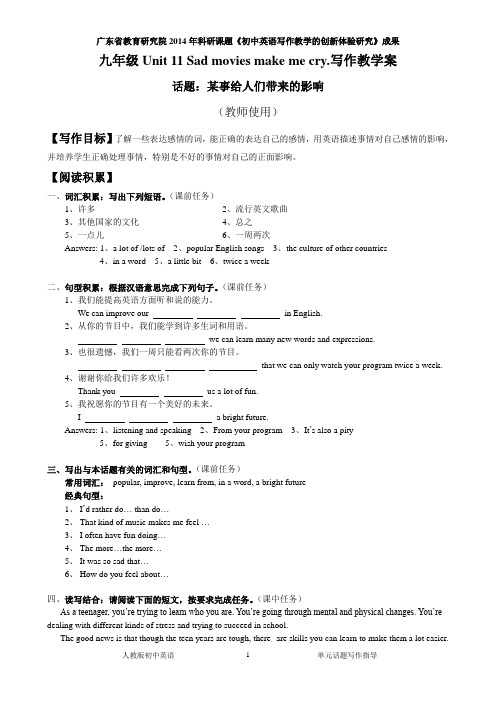
九年级Unit 11 Sad movies make me cry.写作教学案话题:某事给人们带来的影响(教师使用)【写作目标】了解一些表达感情的词,能正确的表达自己的感情,用英语描述事情对自己感情的影响,并培养学生正确处理事情,特别是不好的事情对自己的正面影响。
【阅读积累】一、词汇积累:写出下列短语。
(课前任务)1、许多2、流行英文歌曲3、其他国家的文化4、总之5、一点儿6、一周两次Answers: 1、a lot of /lots of 2、popular English songs 3、the culture of other countries4、in a word5、a little bit6、twice a week二、句型积累:根据汉语意思完成下列句子。
(课前任务)1、我们能提高英语方面听和说的能力。
We can improve our in English.2、从你的节目中,我们能学到许多生词和用语。
we can learn many new words and expressions.3、也很遗憾,我们一周只能看两次你的节目。
that we can only watch your program twice a week.4、谢谢你给我们许多欢乐!Thank you us a lot of fun.5、我祝愿你的节目有一个美好的未来。
I a bright future.Answers: 1、listening and speaking 2、From your program 3、It’s also a pity5、for giving 5、wish your program三、写出与本话题有关的词汇和句型。
(课前任务)常用词汇:popular, improve, learn from, in a word, a bright future经典句型:1、I’d rather do… than do…2、That kind of music makes me feel …3、I often have fun doing…4、The more…the more…5、It was so sad that…6、How do you feel about…四、读写结合:请阅读下面的短文,按要求完成任务。
人教版九年级英语全册Unit11教学设计
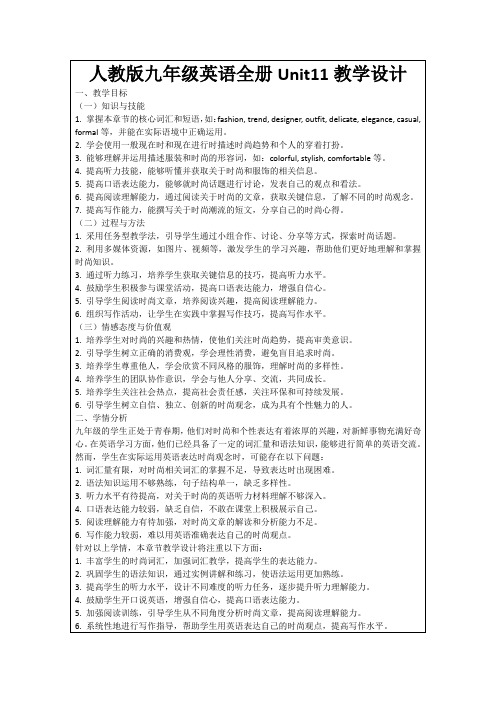
一、教学目标
(一)知识与技能
1.掌握本章节的核心词汇和短语,如:fashion, trend, designer, outfit, delicate, elegance, casual, formal等,并能在实际语境中正确运用。
2.学会使用一般现在时和现在进行时描述时尚趋势和个人的穿着打扮。
7.提高写作能力,能撰写关于时尚潮流的短文,分享自己的时尚心得。
(二)过程与方法
1.采用任务型教学法,引导学生通过小组合作、讨论、分享等方式,探索时尚话题。
2.利用多媒体资源,如图片、视频等,激发学生的学习兴趣,帮助他们更好地理解和掌握时尚知识。
3.通过听力练习,培养学生获取关键信息的技巧,提高听力水平。
-阅读分析:让学生阅读不同风格的时尚文章,分析文章结构和作者观点。
-写作指导:提供写作框架和指导,帮助学生撰写关于时尚潮流的短文。
四、教学内容与过程
(一)导入新课
1.教师以一首时尚主题的歌曲或视频作为课堂导入,激发学生的兴趣和好奇心。
2.引导学生关注视频中的时尚元素,如服饰、配饰、发型等,让学生初步感知时尚的魅力。
3.能够理解并运用描述服装和时尚的形容词,如:colorful, stylish, comfortable等。
4.提高听力技能,能够听懂并获取关于时尚和服饰的相关信息。
5.提高口语表达能力,能够就时尚话题进行讨论,发表自己的观点和看法。
6.提高阅读理解能力,通过阅读关于时尚的文章,获取关键信息,了解不同的时尚观念。
-长文章听力:让学生听关于时尚潮流的长文章,培养他们的整体理解和细节捕捉能力。
5.口语交流:设计丰富的口语活动,鼓励学生大胆开口,提高口语表达能力。
人教版九年级英语全册Unit11优秀教学案例

(一)导入新课
1.利用多媒体展示一系列环保现象,如污染、浪费等,引发学生对环保的思考。
2.组织学生进行自由谈话,让学生分享自己对环保的认识和看法。
3.教师通过提问方式,引导学生思考环保的重要性,为新课的学习做好铺垫。
4.引入本节课的主题,明确学习目标,激发学生的学习兴趣。
(二)讲授新知
教学目标明确,教学内容与现实生活紧密相连,使学生在学习过程中能够更好地将所学知识运用到实际生活中。在教学过程中,注重发挥学生的主体作用,鼓励他们积极参与课堂讨论,提高他们的口语表达能力和团队协作能力。同时,结合我国环保政策的实际情况,引导学生正确理解环保的重要性,树立正确的价值观。
二、教学目标
(一)知识与技能
4.多样化的教学策略,提高学生综合能力:本案例采用了情景创设、问题导向、小组合作等多种教学策略,使学生在实际情境中运用所学知识,提高了口语表达、团队协作等综合能力。
5.结合实际国情,引导学生正确理解环保重要性:教师在教学过程中,结合我国环保政策的实际情况,引导学生正确理解环保的重要性,使学生明白保护环境是每个人的责任。这种教学方式有助于培养学生的社会责任感,使他们愿意为我国的环保事业贡献自己的力量。
三、教学策略
(一)情景创设
1.通过多媒体展示环保主题的视频,让学生身临其境地感受环保的重要性。
2.利用图片、图表等教学资源,展示环保现象,引发学生思考。
3.创设真实的交流情景,如角色扮演、模拟对话等,使学生在实际情境中运用所学知识。
4.组织学生参观环保设施,如污水处理厂、垃圾回收站等,增强学生的直观感受。
本案例通过以上五个亮点,展现了一堂生动、有趣的英语课堂。教师以学生为主体,注重培养学生的自主学习能力和批判性思维。同时,结合我国环保政策的实际情况,引导学生正确理解环保的重要性,树立正确的价值观。在教学过程中,教师运用多样化的教学策略,提高学生的综合能力,为学生的全面发展奠定了基础。
人教版九年级全册Unit11SectionAGrammarFocus教学设计

(一)教学重难点
1.重点:本章节的重点在于让学生掌握过去进行时的用法,并能运用该时态进行情景对话和描述过去某个时间点正在进行的动作。
2.难点:如何让学生正确区分过去进行时与一般过去时,并在实际语境中灵活运用;以及如何引导学生运用所学词汇进行创造性表达。
(二)教学设想
针对上述重难点,我设想以下教学策略:
4.九年级学生正处于青春期,具有强烈的求知欲和表现欲,教师可充分利用这一特点,设计有趣的教学活动,激发学生的学习兴趣。
5.学生在小组合作中,有时分工不明确,导致合作效果不佳。教师应引导学生明确各自职责,提高合作学习的效果。
在此基础上,本章节的教学应注重个体差异,关注不同学生的学习需求,充分调动学生的积极性,提高他们的语法运用能力。
2.邀请学生分享他们在过去某个时间点正在进行的有趣活动,为引入过去进行时做好铺垫。
3.通过复习一般过去时,引导学生发现过去进行时的特点,为新课的学习做好过渡。
(二)讲授新知
1.教师以讲解、示范的方式,向学生介绍过去进行时的结构:was/were +动词的现在分词。结合图片和实例,让学生理解过去进行时的用法。
五、作业布置
为了巩固本节课所学内容,确保学生对过去进行时的掌握,特布置以下作业:
1.编写一篇日记,描述昨天你在学校的一天。要求运用过去进行时描述你在不同时间段正在进行的动作,如:“When the bell rang, I was discussing the math problem with my deskmate.”
1.创设情境:通过展示与单元话题相关的图片、视频等,让学生身临其境地感受过去进行时,激发他们的学习兴趣。同时,设计具有真实性和趣味性Biblioteka 语境,让学生在实践中掌握语法知识。
人教版英语九年级全册Unit11Sadmoviesmakemecry大单元教学设计

3.教师将对学生的作业进行认真批改,并及时给予反馈,指导学生改进学习方法。
5.团队合作:学生在小组活动中,团队合作能力有待提高。教师应关注学生在团队合作中的表现,引导他们学会相互支持、共同进步。
三、教学重难点和教学设想
(一)教学重难点
1.重点:
(1)掌握本单元的新词汇和短语,如“touching”, “emotional”, “tearjerker”, “cinema”等,并能熟练运用。
(二)过程与方法
在本章节的教学过程中,教师将采用以下方法,引导学生达成教学目标:
1.采用情境教学法,通过播放电影片段,让学生在真实的语境中感知、理解并运用所学词汇和语法。
2.利用任务型教学法,设计小组讨论、角色扮演等活动,培养学生合作、交流的能力。
3.通过阅读课文,引导学生运用预测、扫读、精读等策略,提高阅读理解能力。
3.邀请学生分享自己观看过的感人电影,讨论电影中的感人之处,为新课的学习做好情感铺垫。
(二)讲授新知
1.教师呈现本节课的新词汇和短语,如“touching”, “emotional”, “tearjerker”, “cinema”等,通过例句、图片等形式,帮助学生理解和记忆。
2.讲解一般现在时和一般过去时的用法,结合电影情节,让学生在实际语境中感受两种时态的运用。
(五)总结归纳
1.教师引导学生回顾本节课所学内容,总结一般现在时和一般过去时的用法,以及电影情节描述的方法。
2.学生分享自己在课堂上的收获和感悟,交流学习方法,提高学习效果。
3.教师强调电影中的情感表达,引导学生关注他人的情感需求,培养同理心。
4.布置课后作业,要求学生观看一部电影,结合所学知识撰写观后感,巩固所学内容。
人教版九年级英语全册Unit11SectionA3a3c教学设计
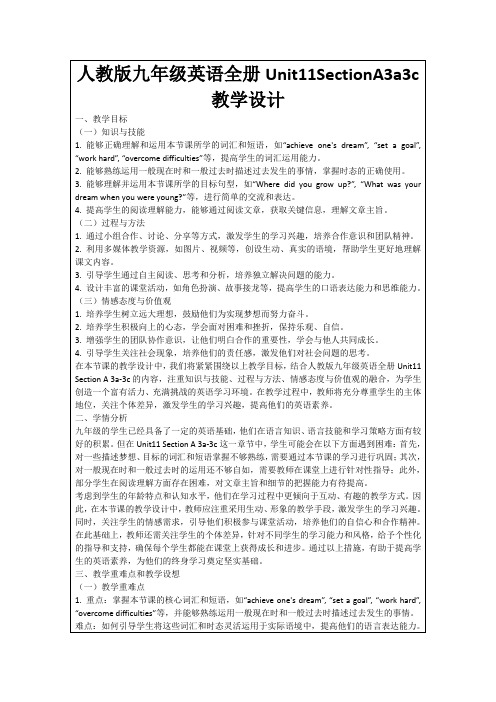
7.课后反思:要求学生反思本节课的学习过程,总结自己在学习中的优点和不足,为下一节课的学习做好准备。
1.完成课本练习册中与本节课相关的练习题,包括词汇填空、时态选择题和阅读理解题,以加深对词汇、短语和时态知识的掌握。
2.结合本节课所学内容,以“我的梦想”为主题,写一篇不少于80词的英语短文,要求运用一般现在时和一般过去时描述自己的梦想及为实现梦想所付出的努力。此作业旨在提高学生的写作能力和语言表达能力。
2.重点:培养学生通过阅读获取关键信息,理解文章主旨的能力。
难点:如何帮助学生克服阅读理解中的困难,提高他们的阅读策略和技巧。
3.重点:激发学生的学习兴趣,培养他们的合作意识和团队精神。
难点:如何针对学生的个体差异,设计富有挑战性和趣味性的课堂活动,使每个学生都能积极参与并取得进步。
(二)教学设想
1.采用情境教学法,创设与课文内容相关的真实语境,让学生在交流互动中自然地学习和运用英语。例如,通过角色扮演、小组讨论等形式,引导学生运用所学词汇和句型描述自己的梦想和成长经历。
四、教学内容与过程
(一)导入新课
在本节课的导入环节,教师将通过以下方式激发学生的学习兴趣和好奇心:
1.利用多媒体展示一组著名人士实现梦想的照片,如篮球运动员姚明、科学家爱因斯坦等,引导学生观察并思考:“What do you think these people have in common? What do you think their dreams were when they were young?”
4.重视课堂反馈,及时调整教学策略。在教学过程中,教师要注意观察学生的反应,了解他们在学习中的困难,针对性地进行解答和指导。
人教版九年级英语全册Unit11单元教学设计

4.教师引导学生关注课文中的成功人士故事,学习他们的成功经验。
-师:From the story, what qualities do you think are important for being successful?
2.学生快速阅读课文,教师提问检查学生对课文的理解。
-师:What's the main idea of the passage? Can you find out some key words and phrases about achieving goals?
3.教师详细讲解课文中的重点词汇和句型,如:achieve, goal, succeed, determination等,并通过示例句展示语法结构。
(三)学生小组讨论
1.教师将学生分成小组,让他们讨论以下问题:
- What are your goals for the future?
- How can you achieve your goals?
- Can you share some successful people's stories you know?
4.针对情感态度和价值观的培养,采用以下策略:
-结合课文内容,引导学生开展人生规划和目标设定的讨论,激发他们的梦想和激情。
-举办成长故事分享会,让学生从他人的经历中汲取正能量,培养积极向上的心态。
-开展公益活动,让学生在实际行动中体验助人为乐的价值观。
人教版九年级英语全册Unit11单元整体教学设计
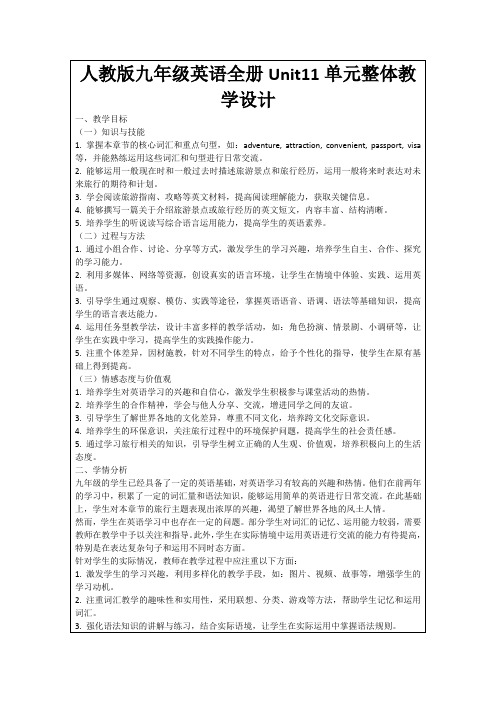
3.强化语法知识的讲解与练习,结合实际语境,让学生在实际运用中掌握语法规则。
4.针对学生个体差异,实施分层教学,关注每个学生的学习需求,提高他们的自信心和学习积极性。
5.创设丰富的语言环境,鼓励学生大胆开口,提高学生的听说能力和口语表达能力。
人教版九年级英语全册Unit11单元整体教学设计
一、教学目标
(一)知识与技能
1.掌握本章节的核心词汇和重点句型,如:adventure, attraction, convenient, passport, visa等,并能熟练运用这些词汇和句型进行日常交流。
2.能够运用一般现在时和一般过去时描述旅游景点和旅行经历,运用一般将来时表达对未来旅行的期待和计划。
四、教学内容与过程
(一)导入新课(500字)
1.教师通过展示一组世界各地旅游景点的图片,引导学生观察并询问:“Where have you been? Where would you like to go?”,让学生分享自己的旅行经历和梦想。
2.学生分享后,教师引入本节课的主题:“Today, we are going to learn about travels and adventures. We will talk about some famous attractions and our travel experiences.”
五、作业布置
为了巩固本节课所学知识,培养学生的自主学习能力和实际运用能力,特布置以下作业:
1.完成课后练习册的相关练习,巩固词汇和语法知识。
-选择题:检测学生对词汇和时态知识的掌握程度。
-填空题:培养学生运用所学词汇和句型进行填空的能力。
人教版英语九年级全册Unit11Sadmoviesmakemecry
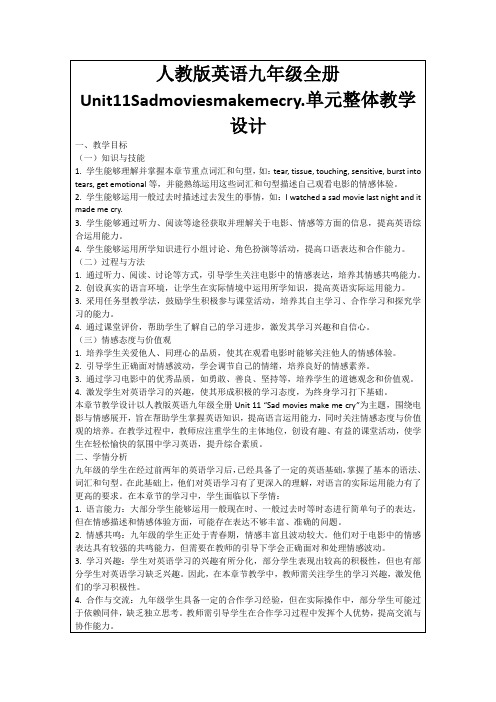
1.通过听力、阅读、讨论等方式,引导学生关注电影中的情感表达,培养其情感共鸣能力。
2.创设真实的语言环境,让学生在实际情境中运用所学知识,提高英语实际运用能力。
3.采用任务型教学法,鼓励学生积极参与课堂活动,培养其自主学习、合作学习和探究学习的能力。
4.通过课堂评价,帮助学生了解自己的学习进步,激发其学习兴趣和自信心。
6.反思与评价:要求学生撰写一份学习反思,总结自己在本节课的学习过程中的收获和不足,并提出改进措施。
目的:培养学生的自我反思和评价能力,激发学习兴趣,为下一节课的学习做好准备。
在作业布置过程中,教师应关注学生的个体差异,合理调整作业难度,使每个学生都能在完成作业的过程中获得成就感。同时,鼓励学生积极参与作业讨论,与家长分享学习成果,提高学习积极性。通过本次作业的完成,期望学生能够更好地掌握所学知识,提高英语综合素质。
2.情感共鸣:九年级的学生正处于青春期,情感丰富且波动较大。他们对于电影中的情感表达具有较强的共鸣能力,但需要在教师的引导下学会正确面对和处理情感波动。
3.学习兴趣:学生对英语学习的兴趣有所分化,部分学生表现出较高的积极性,但也有部分学生对英语学习缺乏兴趣。因此,在本章节教学中,教师需关注学生的学习兴趣,激发他们的学习积极性。
2.教学方法:采用个人练习、小组竞赛等形式,激发学生的学习积极性。
3.课堂互动:教师邀请学生展示自己的练习成果,其他学生进行评价,共同提高。
4.教学目的:巩固新知识,提高学生的实际运用能力。
(五)总结归纳
1.教学内容:对本节课的重点词汇、句型和一般过去时进行回顾和总结。
2.教学方法:采用问答、思维导图等形式,帮助学生梳理所学知识。
3.学生分享:邀请几位学生分享自己的情感体验,其他学生认真倾听,为接下来的课堂讨论做好铺垫。
人教版英语九年级全册Unit11教学设计
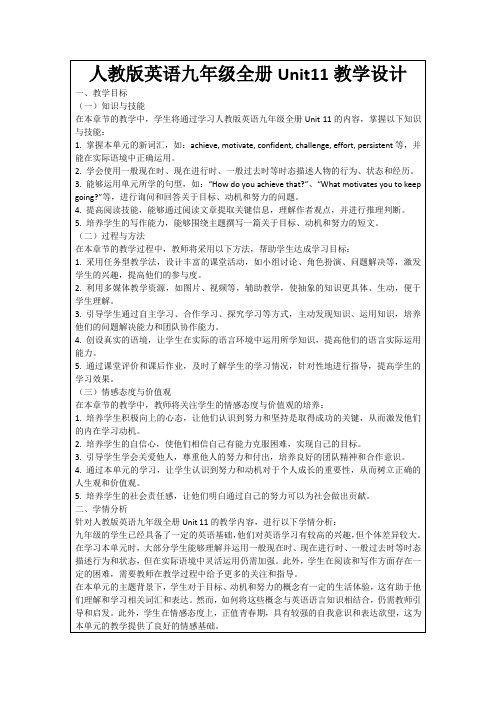
-培养学生的合作意识,提高他们的沟通能力。
-让学生通过讨论,加深对目标、动机和努力的理解。
(四)课堂练习
1.教学内容:
-设计不同层次的练习,包括词汇填空、句型转换、阅读理解和写作等。
-练习涵盖本节课所学的知识点,让学生在实际操作中巩固所学。
2.教学方法:
-逐层递进,由浅入深地设计练习,使不同水平的学生都能得到有效训练。
在本章节的教学中,教师将关注学生的情感态度与价值观的培养:
1.培养学生积极向上的心态,让他们认识到努力和坚持是取得成功的关键,从而激发他们的内在学习动机。
2.培养学生的自信心,使他们相信自己有能力克服困难,实现自己的目标。
3.引导学生学会关爱他人,尊重他人的努力和付出,培养良好的团队精神和合作意识。
-将学生分成小组,讨论以下问题:“What is your dream?”、“What motivates you to achieve your dream?”、“How do you overcome challenges and make efforts?”
-各小组选取一名代表汇报讨论成果,其他组成员进行补充。
-分析一般现在时、现在进行时、一般过去时等时态在本单元中的应用。
-通过课文示例,教授如何使用单元所学的句型进行询问和回答关于目标、动机和努力的问题。
2.教学方法:
-采用直观教学法,通过图片、实例等展示词汇和语法点。
-设计真实语境,让学生在实际交流中感受和理解新知识。
(三)学生小组讨论
1.教学活动设计:
3.引导学生通过自主学习、合作学习、探究学习等方式,主动发现知识、运用知识,培养他们的问题解决能力和团队协作能力。
4.创设真实的语境,让学生在实际的语言环境中运用所学知识,提高他们的语言实际运用能力。
人教版九年级英语全册Unit11单元优秀教学案例
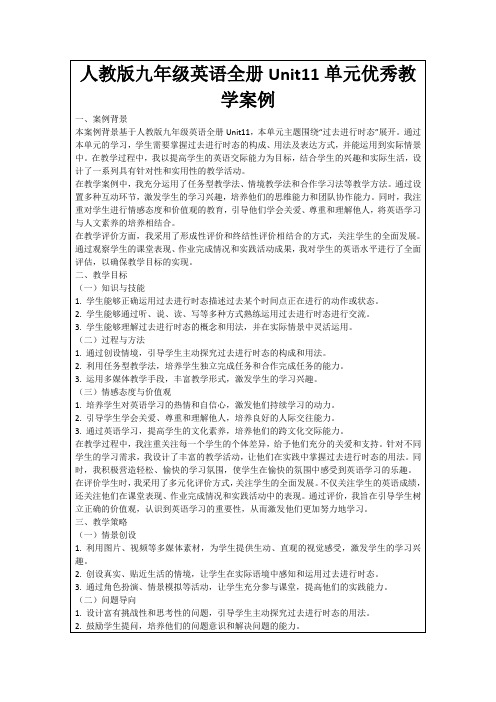
(三)学生小组讨论
1.将学生分成若干小组,每组选择一个日常生活中的场景,如“昨天在学校发生了什么?”
2.要求学生用过去进行时态进行交流,培养他们的实践能力和团队协作能力。
3.教师巡回指导,给予学生必要的帮助和指导。
(四)总结归纳
1.邀请学生代表分享他们小组讨论的成果,让学生在交流中巩固过去进行时态的用法。
人教版九年级英语全册Unit11单元优秀教学案例
一、案例背景
本案例背景基于人教版九年级英语全册Unit11,本单元主题围绕“过去进行时态”展开。通过本单元的学习,学生需要掌握过去进行时态的构成、用法及表达方式,并能运用到实际情景中。在教学过程中,我以提高学生的英语交际能力为目标,结合学生的兴趣和实际生活,设计了一系列具有针对性和实用性的教学活动。
五、案例亮点
1.情境创设丰富多样:本案例中,教师利用多媒体展示图片、视频等素材,为学生提供了生动、直观的视觉感受,激发了学生的学习兴趣。同时,教师还创设了真实、贴近生活的情境,让学生在实际语境中感知和运用过去进行时态,提高了他们的实践能力。
2.问题导向激发思考:教师设计了富有挑战性和思考性的问题,引导学生主动探究过去进行时态的用法。通过鼓励学生提问和互相讨论,培养了他们的问题意识和解决问题的能力,使他们能够更深入地理解过去进行时态。
在教学过程中,我注重关注每一个学生的个体差异,给予他们充分的关爱和支持。针对不同学生的学习需求,我设计了丰富的教学活动,让他们在实践中掌握过去进行时态的用法。同时,我积极营造轻松、愉快的学习氛围,使学生在愉快的氛围中感受到英语学习的乐趣。
在评价学生时,我采用了多元化评价方式,关注学生的全面发展。不仅关注学生的英语成绩,还关注他们在课堂表现、作业完成情况和实践活动中的表现。通过评价,我旨在引导学生树立正确的价值观,认识到英语学习的重要性,从而激发他们更加努力地学习。
人教版英语九年级全册Unit11Sadmoviesmakemecry大单元优秀教学案例

三、教学策略
(一)情景创设
1.生活情境:以学生熟悉的电影院为背景,设计一系列真实情境的任务,如购买电影票、选择座位、讨论电影等,让学生在实际情境中运用所学知识。
2.角色扮演:学生分组扮演不同的角色,如导演、演员、观众等,通过模拟电影制作和观影过程,让学生身临其境地学习英语。
5.教学评价:本案例采用了多元化的评价方式,既注重学生的语言能力,也注重他们的情感态度价值观。学生自我评价、同伴评价和教师评价相结合,使评价更加全面、客观,有助于激发学生的学习积极性,提高他们的自我认知能力。
3.任务驱动:设计具有挑战性的任务,如编写电影剧本、拍摄电影短片等,让学生在完成任务的过程中,主动探索和解决问题。
(三)小组合作
1.小组讨论:学生分组进行讨论,分享自己的观点和经验,通过互相交流和合作,共同完成任务。
2.小组表演:学生分组表演电影场景,锻炼他们的口语表达能力和团队协作能力。
3.小组评价:学生互相评价对方的表现,提出改进意见,促进彼此的进步。
பைடு நூலகம்(二)讲授新知
1.教师展示一组电影图片,包括喜剧、悲剧、爱情等不同类型的电影,让学生观察并说出它们的特征。
2.教师引导学生学习本节课的重点单词和短语,如“movie”, “actress”, “actor”, “director”等,并通过例句展示如何运用这些词汇。
3.教师讲解本节课所学的句型,如“I think...”, “I believe...”, “It's because...”等,并给出实例,让学生理解并模仿运用。
3.情感体验:通过观看感人的电影片段,引导学生体验不同情感,如快乐、悲伤、愤怒等,激发学生的情感共鸣,促进他们对英语学习的兴趣。
人教版英语九年级全册Unit11Sadmoviesmakemecry

2.学生独立完成练习题,教师巡回指导,解答学生疑问。
3.教师选取部分学生的练习成果进行展示和评价,引导学生互相学习,共同进步。
(五)总结归纳
1.教师引导学生回顾本节课所学的词汇、语法和句型,总结观看感人电影的经历。
-教师可以通过提问方式帮助学生梳理所学内容,如:“What words did we learn today? Can you use them to describe a touching movie?”
2.能力水平:九年级学生的英语听力、口语、阅读和写作能力已有一定的发展,但仍有待提高。本章节将通过丰富的教学活动,帮助学生提高这些方面的能力,特别是听力理解和写作表达。
3.情感态度:九年级学生正处于青春期,情感丰富,容易受到感人情节的影响。本章节以感人电影为话题,有助于激发学生的情感共鸣,提高他们对英语学习的兴趣。
(3)引导学生关注电影中的语音现象,提高听力理解能力。
3.针对口语教学,采用以下设想:
(1)组织学生进行角色扮演,让他们在真实语境中运用所学知识。
(2)开展小组讨论,鼓励学生发表个人观点,提高口语表达能力。
(3)给予学生充分的鼓励和肯定,增强他们开口说英语的自信心。
4.针对写作教学,采用以下设想:
(1)提供写作框架,引导学生逐步完成写作任务。
2.能够运用过去时态描述过去发生的事情,特别是观看电影的经历。
3.能够运用英语讨论个人对电影的喜好,表达自己的观点和感受。
4.能够听懂并参与关于电影话题的讨论,提高听力理解能力。
5.能够撰写一篇关于观看感人电影经历的英语短文,提升写作能力。
(二)过程与方法
在本章节的教学过程中,学生将通过以下方法提升学习效果:
人教版新目标英语九年级Unit 11 单元话题写作教学案

九年级Unit 11 Sad movies make me cry.写作教学案(教师使用)【话题】情感(Feelings)【写作目标】了解一些表达感情的词,能正确的表达自己的感情,用英语描述事情对自己感情的影响,并培养学生正确处理事情,特别是不好的事情对自己的正面影响。
【课前任务】一、写出下列短语。
1、许多2、流行英文歌曲3、其他国家的文化4、总之5、一点儿6、一周两次参考答案:1. a lot of /lots of 2. popular English songs 3. the culture of other countries 4. in a word 5.a little bit 6. twice a week二、根据汉语意思完成下列句子。
1、我们能提高英语方面听和说的能力。
We can improve our in English.2、从你的节目中,我们能学到许多生词和用语。
we can learn many new words and expressions.3、也很遗憾,我们一周只能看两次你的节目。
that we can only watch your program twice a week.4、谢谢你给我们许多欢乐!Thank you us a lot of fun.5、我祝愿你的节目有一个美好的未来。
I a bright future.参考答案:1. listening and speaking 2. From your program 3. It’s also a pity 4. for giving 5. wish your program三、写出与本话题有关的词汇和句型。
(课前任务)常用词汇:popular, improve, learn from, in a word, a bright future经典句型:I’d rather do… than do…That kind of music makes me feel …I often have fun doing…The more…the more…It was so sad that…How do you feel about…【课中任务】读写结合一、 A. 信息归纳阅读下面短文,然后按照项目要求填写所缺信息。
人教版英语九年级全册Unit11SectionB1a1e教学设计
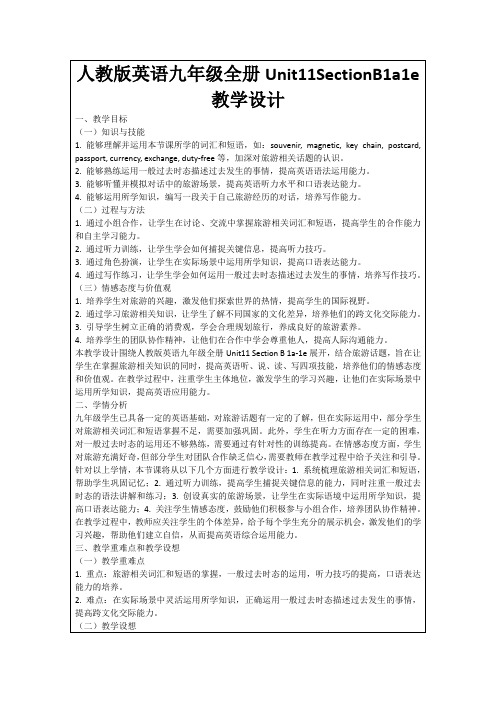
教学语言:Please share your thoughts on what you have learned today.
3.教师总结:强调旅游话题的实际应用,鼓励学生在生活中多运用英语。
教学语言:Remember, the knowledge we learned today can be used in real-life situations. Try to use English more often when talking about traveling.
4.观看一部英文旅游纪录片,记录下自己感兴趣的片段,并尝试用英语概括纪录片的主要内容。
教学语言:Watch an English travel documentary and take notes on the interesting parts. Then, try to summarize the main content of the documentary in English.
3.收集并整理一些旅游景点的图片或明信片,用英语描述这些景点,并与同学分享。
教学语言:Collect and organize some pictures or postcards of tourist attractions. Describe these attractions in English and share them with your classmates.
二、学情分析
九年级学生已具备一定的英语基础,对旅游话题有一定的了解,但在实际运用中,部分学生对旅游相关词汇和短语掌握不足,需要加强巩固。此外,学生在听力方面存在一定的困难,对一般过去时态的运用还不够熟练,需要通过有针对性的训练提高。在情感态度方面,学生对旅游充满好奇,但部分学生对团队合作缺乏信心,需要教师在教学过程中给予关注和引导。
《Unit 11 The happiest life!—Writing》教案

九年级英语第11单元教学设计Unit 11 The happiest life!—Writing一、教学设计理念、思路:(一)把课堂变成学堂,以学生为主、从学生学的角度设计教学活动,注重学生的学习能力。
(二)通过独学、群学以及小组合作、进行分享与赏析习作,培养学生的合作探究能力。
(三)以读促写,关注篇章结构和语篇词汇,读写综合。
重视词块的教学、巩固和应用,为写作埋下坚实的铺垫。
(四)注重教给学生学习的方法和写作的方法,尝试写作练习与相互分享教学常态化。
二、单元写作设计内容的基本信息:三、教学对象:九年级学生拥有一定的词汇与句型的积累,具备初步的写作基础。
四、教学目标(一)语言知识与能力目标:1.学会使用本单元所学的词块和句型来表达自己思想、情绪和行为。
2.学习写作的策略,掌握本单元的写作思路与技巧。
(二)能力目标培养学生的合作探究能力、阅读与写作和赏析能力。
(三)情感态度与价值观目标:尝试学习勇敢面对自己的内心情感需求,监控自己的行为,努力实现自己的需求。
培养学生积极向上的心态,珍惜所有人对自己的爱,努力学习让自己变得更加优秀回报父母与社会!五、教学重难点:(一)教学重点:1.能正确运用本单元所学的词块和句型来进行表达。
2.应用所学的内容,完成阅读理解的任务。
3.能综合运用本单元所学习的语言知识来写作有关人物情感与情绪。
(二)教学难点:写作有关人物情感与情绪。
六、教学方法:运用先学后教、以生为本、注重词块与句型的运用、以读促写、注重自主学习与合作探究相结合。
七、教学过程:十、教学反思:【互评互学】【评分标准】Extensive language拓展性语言Famous saying,proverbs and classical sample sentences(名言、谚语与经典例句)1.Happiness consists in contentment. 知足常乐.2.Happy is the man who is living by his hobby.以爱好为生的人是幸福的。
- 1、下载文档前请自行甄别文档内容的完整性,平台不提供额外的编辑、内容补充、找答案等附加服务。
- 2、"仅部分预览"的文档,不可在线预览部分如存在完整性等问题,可反馈申请退款(可完整预览的文档不适用该条件!)。
- 3、如文档侵犯您的权益,请联系客服反馈,我们会尽快为您处理(人工客服工作时间:9:00-18:30)。
1.Impolish your position
2.Try to learn another position
教学反思
2.通过范文赏析,概括经历的写作要点与格式,
3.写一篇80左右的介绍自己一次开心经历的文章。
教学过程
(每个学习目标的达成需呈现学习目标、学习活动、评价标准、教师活动、目标达成情况五个方面)
Before writing
1.本单元写作主题是介绍一次经历。通常涉及事件的时间、地点、经过、自我感受、自我领悟。注意一般过去时在写作中的正确运用。
教材来源
初中九年级《英语》教科书/人民教育出版社
内容来源
九年级《英语》Unit11
主题
Sad movies make me cry.
课时
共5课时第5课目标确定
的依据
《课程标准》的要求
能根据写作要求,收集,准备素材。 能独立起草短文,并在老师的指导下进行修改。
教材分析
本单元写作主题是谈论过去事情的影响。通常涉及事件的时间、地点、经过、自我感受、自我领悟。写作时注意一般过去时在写作中的正确使用。
We had to move because of my father’s new job in another town. That made me sad and worried, and also made my good friends feel unhappy.
The day after we moved to a new house, my parents took me to my new school. I feel really upset. Mr. Lin, my new head teacher, told me to introduce myself to the class. Speaking in front of my new classmates made me want to run away. However, the smiles on their faces encouraged me. After that, I tried to make some new friends. They took me to visit the museums and resd in the library in the free time. Thanks to their help, I got used to the life in the new place quickly.
What happened?
When did it happen?
Where did it happen?
How did it make you feel? Why?
What did you learn from the experience?
I will never forget the days when I moved to a new town.
What happened?
When did it happen?
Where did it happen?
How did it make you feel? Why?
What did you learn from the experience?
2.出示范文,引导学生了解范文的结构层次,及conjuncion(连接)和reference(照应)
学情分析
经过七八年级的写作练习,学生对写作技策略与作文结构都有自己的认知。
学习目标
1.通过研读The Winning Team,概括介绍一次经历作文的内容要点与格式。
2.通过研读范文,概括一次开心经历的写作要点与格式。
3.独立一篇80词左右的介绍自己一次开心经历的文章。
评价任务
1.观察范文,概括经历作文的格式
While writing
1.写作环节趁热打铁,学生根据自己的mind map,运用conjuncion words和reference words的写作策略进行写作。
After writing
1.教师先示范一篇习作,根据评价标准为本篇习作打分,找出优点与缺点。
两人一组,进行互评互阅,引导学生关注能从对方的短文中获取什么信息,看看有没有运用到conjuncion(连接)和reference(照应)的写作策略
From then on, I always tell myself that everything will be OK as long as we are brave enough.
2.让学生自己概括出一次开心经历的写作要点与格式。
1.小组讨论,根据提示词和示例,并记录在3a,形成mind map
